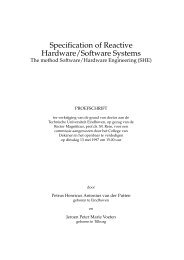MNEMEE - Electronic Systems - Technische Universiteit Eindhoven
MNEMEE - Electronic Systems - Technische Universiteit Eindhoven
MNEMEE - Electronic Systems - Technische Universiteit Eindhoven
You also want an ePaper? Increase the reach of your titles
YUMPU automatically turns print PDFs into web optimized ePapers that Google loves.
Plasma), etc., is enabled by compression/decompression (codec) algorithms that make it possible to<br />
store and transmit digital video. The main goal of video compression is to reduce the vast amount of<br />
data present in the raw format. The resulting encoded video bitstream uses as few bits as possible<br />
while maintaining visual quality. The complementary video decoder converts this compressed form<br />
back into a representation of the original video data. The encoder/decoder pair is often described as a<br />
codec.<br />
If the decoded video sequence is identical to the original, then the coding process is lossless. As<br />
typically only a compression ratio of around 3 to 4 is achieved by lossless image compression<br />
standards, lossy compression is necessary to achieve higher compression factors. Lossy video<br />
compression is based on the principle of removing subjective redundancy: elements of the image or<br />
video sequence that can be removed without significantly affecting the user’s perception of visual<br />
quality. Video codecs are based on the mathematical principles of information theory. As a<br />
consequence of their complexity, building of practical codec implementations requires making delicate<br />
trade-offs that approach being an art form.<br />
16<br />
16<br />
16x16 region<br />
(color)<br />
16<br />
0 1<br />
2 3<br />
Public Page 33 of 87<br />
16<br />
Y<br />
Figure 14 - 4:2:0 macroblock structure.<br />
8<br />
8 8<br />
8<br />
U/Cb V/Cr<br />
All standards of the MPEG-x or H.26x families divide a frame of a video sequence into MacroBlocks<br />
(MB), corresponding to a 16 X 16 pixel region of the frame. For video material in the 4:2:0 format<br />
(the typical raw input format for these video standards), a macroblock contains 6 blocks of 8 X 8<br />
pixels (Figure 14): 4 luminance and 2 chrominance blocks. An MPEG-x or H.26x video codec is<br />
characterized by its block-based processing nature.<br />
8.3.2. A Basic Video Coding Scheme<br />
The main video coding concepts are well described in Chapter 3 of [18], of which this subsection<br />
presents a summary. A basic video encoder (Figure 15) consists of three main functional units: a<br />
temporal model, a spatial model and an entropy encoder. The first processing step, the temporal<br />
model, receives the new raw video data as a current frame. To reduce the temporal redundancy, its<br />
Motion Compensation (MC) exploits the similarities between the current frame and reference frames<br />
(recently coded neighbouring, both previous or future, frames) to predict each (macro)block. The<br />
Motion Estimation (ME) is the part of the temporal model that searches the closest match in the<br />
reference frames for each MB in the current frame. This ME is known as the most performance<br />
intensive function of video compression. The output of the temporal model is a residual/error after MC<br />
(created by subtracting the prediction from the actual current frame) and a set of model parameters,<br />
typically a set of motion vectors describing the relative location of the best match in the reference<br />
frames.
















